





 |

Afghanistan remains one of the states with the highest level of contamination from landmines, improvised mines (IEDs) and explosive remnants of war (ERW), mainly the result of the 1979 Soviet invasion, internal armed conflict from 1992 to 2001, and then the United States-led Coalition`s intervention in late 2001 which added considerable quantities of unexploded ordnance (UXO). At the end of 2019 the Directorate for Mine Action Coordination reported over 1.5 million square meters (370,657) acres of contamination impacting 1,484 communities.
The US Humanitarian Demining Research and Development (HD R&D) Program has deployed 13 technologies to Afghanistan which are being used by the HALO Trust. Detection technologies are the Handheld Standoff Mine Detection System, Minehound and Minehound Lite handheld mine detectors, and the Scorpion UXO system. The most significant of the mechanical systems is the Raptor anti-vehicle mine clearance system consisting of a rotary mine clearing tool called the Rotary Mine Comb integrated onto a modified commercial tractor. Other mechanical systems consist of a variety of sifting systems such as the Orbit Screener, and a suite of area preparation tools. These systems have been used to clear 22,125 mines, 32,935 UXO and 23,829,496 square meters of land as of the end of 2020.
Sources: To Walk the Earth in Safety, 2023
Landmine Monitor Report, 2020
|
|
MANTIS |
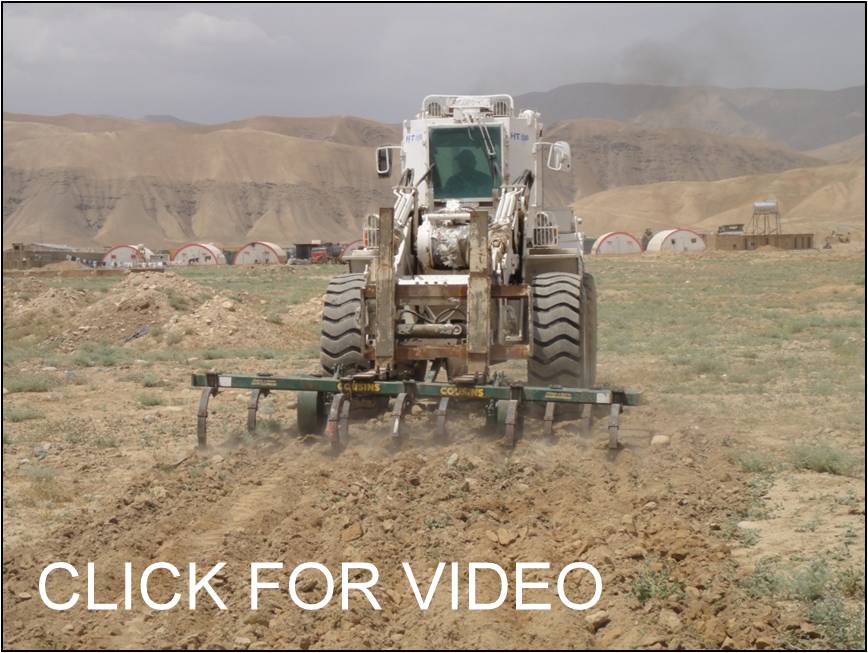
|
Mantis is a suite of specialized attachments used in mine action. The attachments, designed for integration onto armored farm tractor class host vehicles, include an anti-personnel mine roller, a vegetation cutter, magnet, plow, rake, sifter, and a standard front loader. The tractor`s cab and engine compartment are armored to provide protection for the operator. Mantis has been fitted with antipersonnel mine survivable SETCO tires and an innovative wheel hub that allows the wheel to separate from the axle in the event of an anti-tank mine detonation. Distribution Statement A: Approved for public release.




PARTNERS: The HALO Trust - Afghanistan
|
|
STORM |
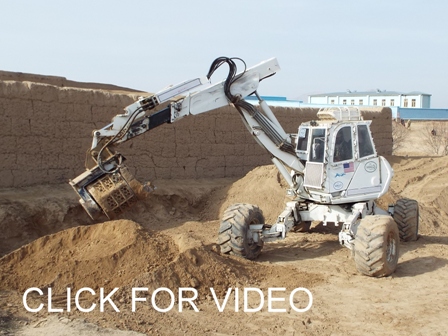
|
The Severe Terrain Off-Road Menzi Muck, or STORM, is a commercial excavator designed to remove vegetation in rough and steep terrain. Its four spider-like legs allow the excavator to work on slopes of up to 70 degrees and maneuver around obstacles with ease. Dual hydraulic pumps enable it to use a wide variety of commercial attachments, including a unique cutting head that can cut trees up to 20 centimeters in diameter. Additionally, the system`s hydraulic lines are designed to shut off flow to the ruptured circuit in the event of a mine blast. Distribution Statement A: Approved for public release.



PARTNERS: The HALO Trust - Afghanistan, Cambodia (2009-2015)
|
|
RAPTOR |
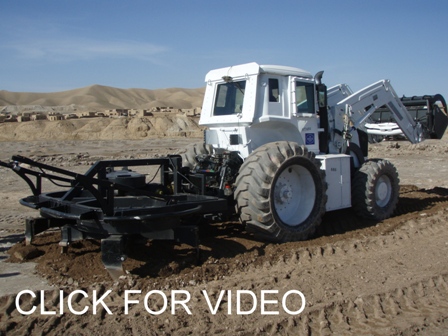
|
The Raptor, a commercial reverse station Fendt farm chassis, has been armored for use as a mine clearance tractor. A suite of commercial and specialized attachments, including cutter, grapnel bucket, chisel plow, cultivator, power harrow, magnet, rotary mine comb, roller, and rock bucket, provide a "tool box" approach to area reduction and preparation.
Distribution Statement A: Approved for public release.




PARTNERS: The HALO Trust - Afghanistan
|
|
ROTARY MINE COMB |
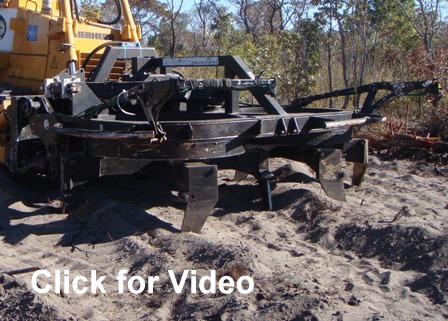
|
The Rotary Mine Comb is an innovative tool capable of gently extricating buried objects from the soil and pushing them to the side of the host vehicle`s path. The comb`s two rotors each contain four soil-engaging tines that intermesh and counter-rotate as the vehicle travels forward. The tines lift and continuously nudge large objects, including anti-tank mines, from the path of the vehicle to the outside edge for neutralization without creating a large berm.
Distribution Statement A: Approved for public release.




PARTNERS: The HALO Trust - Afghanistan, Angola (2008-2013)
|
|
ORBIT SCREENER |
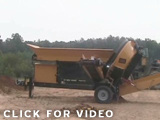
|
The Orbital Action Screening Plant Model 68 efficiently sifts through a variety of soil types for landmines of all sizes. Material is loaded into the 1.8 cubic-yard hopper and fed into a rotating and tilted screen of appropriate size that quickly separates large and/or light items from soil. The highly portable and user friendly Orbit Screen is highly resistant to plugging with plastic, paper, sticks, and vegetation.
Distribution Statement A: Approved for public release.



PARTNERS: Ecuador (2010); The HALO Trust - Afghanistan, The HALO Trust - Mozambique (2011-2014); Mines Advisory Group - Iraq
|
|
Multi-tool Attachments |
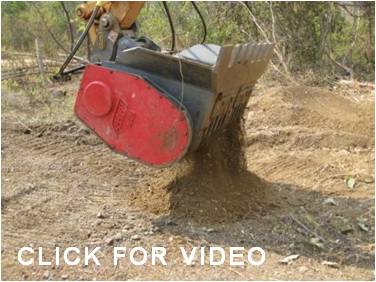
|
The Humanitarian Demining Research and Development (HD R&D) Program has developed a wide variety of excavator and loader based tools for mechanical mine clearance. These attachments give deminers the capability to perform area preparation, technical survey and mine clearance from a safe area. Tools that have proven useful include vegetation cutters, grapples, tillers, and buckets for sifting, grinding, and crushing. The HD R&D Program has modified several small, medium and large class excavators with armor protection and the interfaces needed to use these tools in various demining environments. Operational Field Evaluations (OFE) can be performed with HD R&D Program developed excavators or loaders, or with just the tools mounted to the demining organization`s own host equipment.
Distribution Statement A: Approved for public release.



PARTNERS: Mines Advisory Group; Golden West Humanitarian Foundation; The HALO Trust
|
|
Scorpion |
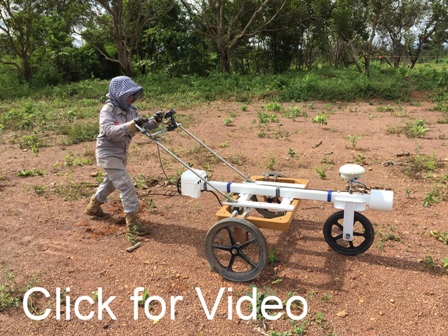
|
Scorpion is a man-portable unexploded ordnance (UXO) detection system that utilizes a one meter wide electro-magnetic induction (EMI) sensor and a total field magnetometer to detect buried UXO objects in an overpass mode. The system uses differential global positioning system (DGPS) to provide centimeter accuracy of target locations and mapping capability.
Distribution Statement A: Approved for public release.



PARTNERS: Golden West Humanitarian Foundation - Cambodia 2012; Mines Advisory Group - Cambodia; Norwegian People`s Aid - Vietnam, The HALO Trust - Afghanistan, Kosovo
|
|
HSTAMIDS |
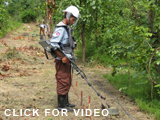
|
The Handheld Standoff Mine Detection System (HSTAMIDS) is the U.S. Army`s AN/PSS-14 dual sensor, handheld mine detector that combines an electromagnetic induction sensor and ground penetrating radar (GPR) to detect landmines. The addition of the GPR significantly reduces the detector`s false alarm rate and the time the operator spends investigating clutter, increasing the operator`s speed and effectiveness. The HD R&D program also developed the HSTAMIDS F3S variant which incorporates a more sensitive metal detector to improve performance against deeply buried low metal anti-personnel and anti-tank mines.
Distribution Statement A: Approved for public release.



PARTNERS: The Halo Trust in Afghanistan, Cambodia, Mozambique (2012-2014), Kosovo,Sri Lanka and Zimbabwe; Mines Advisory Group in Angloa and Cambodia; Cambodia Mine Action Centre (2009-2010); Norwegian Peoples Aid in Zimbabwe (2014-2016)
|
|
Minehound |
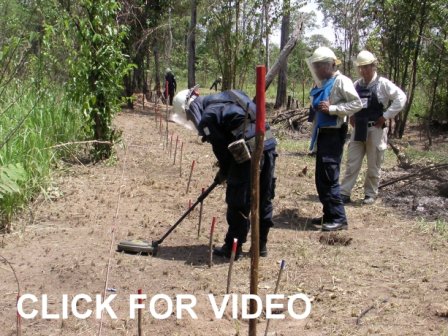
|
Minehound is a commercially available dual sensor handheld detector that uses ground penetrating radar (GPR) and metal detection technology to locate landmines, unexploded ordnance (UXO) and improvised explosive devices (IED). The GPR can be operated independently which gives Minehound the ability to detect deeper buried, low metallic threats. The GPR audio tone provides information on the size and depth of the object it detects. Twenty frequencies are available to the metal detection sub-system, which allows the Minehound to be operated in close proximity to other detectors and near power lines without causing or being subject to interference. The metal detector also compensates for water and mineralized soil without reducing sensitivity.
Distribution Statement A: Approved for public release.



PARTNERS: The HALO Trust - Afghanistan, Angola (2012-2015), Cambodia (2012-2017); MAG - Iraq (Mar-Oct 2017)
|
|
    
|
|

